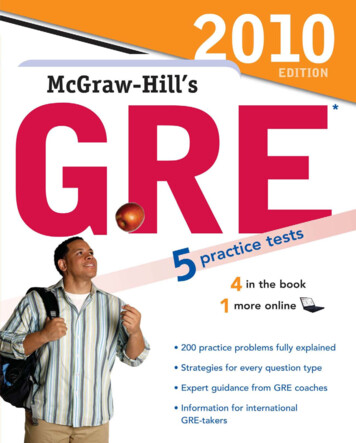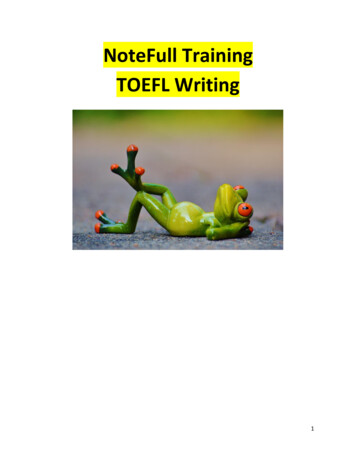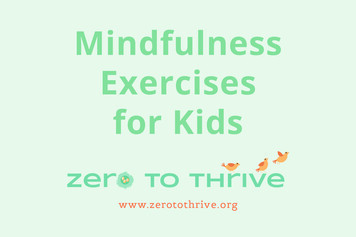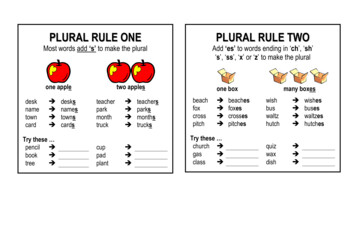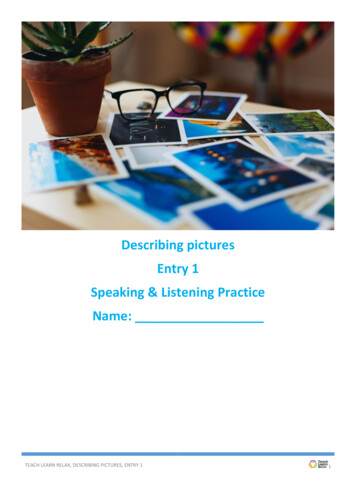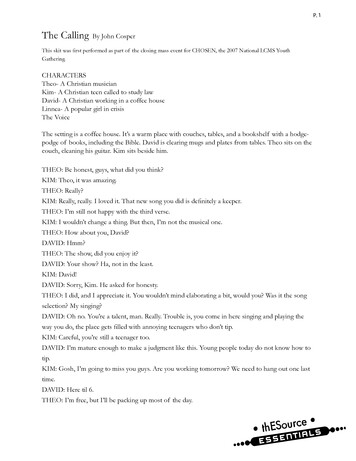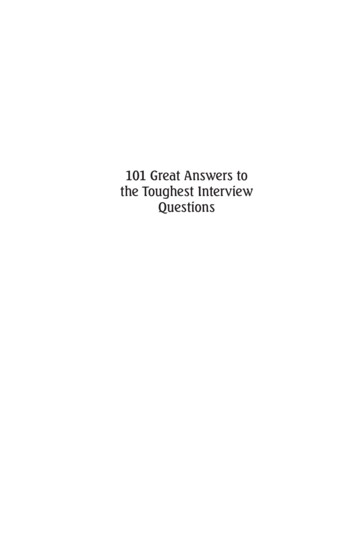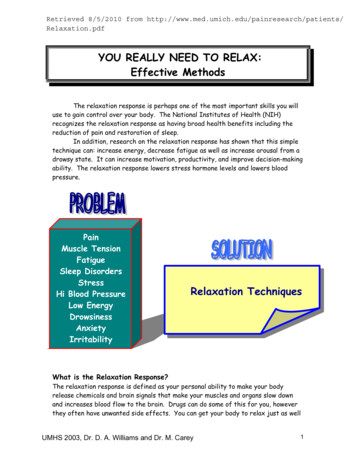
Transcription
Retrieved 8/5/2010 from axation.pdfYOU REALLY NEED TO RELAX:Effective MethodsThe relaxation response is perhaps one of the most important skills you willuse to gain control over your body. The National Institutes of Health (NIH)recognizes the relaxation response as having broad health benefits including thereduction of pain and restoration of sleep.In addition, research on the relaxation response has shown that this simpletechnique can: increase energy, decrease fatigue as well as increase arousal from adrowsy state. It can increase motivation, productivity, and improve decision-makingability. The relaxation response lowers stress hormone levels and lowers bloodpressure.PainMuscle TensionFatigueSleep DisordersStressHi Blood PressureLow EnergyDrowsinessAnxietyIrritabilityRelaxation TechniquesWhat is the Relaxation Response?The relaxation response is defined as your personal ability to make your bodyrelease chemicals and brain signals that make your muscles and organs slow downand increases blood flow to the brain. Drugs can do some of this for you, howeverthey often have unwanted side effects. You can get your body to relax just as wellUMHS 2003, Dr. D. A. Williams and Dr. M. Carey1
without drugs while remaining conscious and aware at the same time. To bephysically relaxed and mentally alert is the goal of the relaxation response.The Relaxation Response is not:¾ Laying on the couch¾ Sleeping¾ Being LazyThe Relaxation Response is:¾ A mentally active process that leaves the body relaxed¾ Best done in an awake state¾ Trainable and becomes more and more profound with practiceThere are many ways of achieving the relaxation response.Some of these techniques are called: Progressive Muscle Relaxation (tense & relax) Visual Imagery Deep Breathing Meditation Hypnosis Yoga BiofeedbackWhich of thesetechniques is best?To date, there is no data supporting the idea that one method is any better thanany other. What does matter is your willingness to use a particular technique foryour own health and your ability to gain relaxation through that method.We will discuss two different versions of the relaxation response: Progressivemuscle relaxation (also known as Tense & Relax) and visual imagery.Progressive Muscle Relaxation (Tense & Relax Technique)Everyone has a resting level of muscle tension. Some people have a great amount oftension at rest, others less. When people are under acute stress, their musclestend to have higher levels of resting tension that can be painful and fatiguing.After you tense and relax muscles, the tension level not only returns to the originalUMHS 2003, Dr. D. A. Williams and Dr. M. Carey2
level, but will automatically drop below the original level, producing even greaterrelaxation to the muscles.333333333Start the exercise by getting comfortable.You can keep your eyes open or shut. Most people prefer to close their eyes.If you are wearing glasses or contact lenses, you may want to remove thembefore starting the exercise.Try not to fall asleep.As you perform this exercise, you will tensedifferent muscle groups above their normal level oftension.When tensing, you need not tense to the point ofpain – simple tensing for 2 seconds is generallysufficient.Focus on how the tension feels. Then, let thetension go.Focus on the sensations of relaxation.Continue to breathe deeply and regularly throughout the exercise.After you have become skilled at using this technique, you can repeatparts of it in a shorter format when you need a quick relaxation break.For example, when sitting in traffic, you can tense the muscles in yourshoulders and upper back and then relax them to get a nice burst ofrelaxation.Are you ready to learn the tense and relax technique?Let’s go!UMHS 2003, Dr. D. A. Williams and Dr. M. Carey3
SKILL: The Tense & Relax TechniquePurpose: to relax your body without the use of drugsGoal: to tense and relax various muscle groups of the body to producerelaxationStep 1: Begin deep breathing.Step 2: Tense the muscle groups (as described below) and then relax them.The Tense & Relax Exercise:Preparation1) Make yourself as comfortable as possible in a seated position2) Try and sit up straight with good posture with your hands resting in your lap3) Remove your glasses if you wear them, some people prefer to remove theircontact lensesTensing and Relaxing Specific Muscle Groups1. Relaxation of the feet and calves:á Flex your feet (pull toes toward the knees)á Contract calf muscles and muscles of lower legá Feel the tension build and hold the tensioná Take a deep breathá As you exhale say the word “RELAX” and let the tension go2. Relaxation of the knees and upper thighs:á Straighten your knees and squeeze your legs togetherá Contract your thigh muscles and all the muscles of your legsá Feel the tension build and hold the tensioná Take a deep breathá As you exhale say the word “RELAX” and let the tension go3. Relaxation of the hips and buttocksá Tense the buttock muscles by squeezing them inward and upwardá Feel the tension build and hold the tensioná Take a deep breathá As you exhale say the word “RELAX” and let the tension goUMHS 2003, Dr. D. A. Williams and Dr. M. Carey4
4. Relaxation of the abdomená Observe your abdomen rising and falling with each breathá Inhale and press your navel toward the spine then tense the abdomená Feel the tension build and hold the tensioná Take a deep breathá As you exhale say the word “RELAX” and let the tension go5. Relaxation of the upper backá Draw the shoulder blades together to the midline of the bodyá Contract the muscles across the upper backá Feel the tension build and hold the tensioná Take a deep breathá As you exhale say the word “RELAX” and let thetension go6. Relaxation of the Arms and Palms of the Handsá Turn palms face down and make a tight fist in eachhandá Raise and stretch both arms with fistsá Feel the tension build and hold the tensioná Take a deep breathá As you exhale say the word “RELAX” and let the tension go7. Relaxation of the Chin, Neck, and Shouldersá Drop your chin to your chestá Draw your shoulders up toward your earsá Feel the tension build and hold the tensioná Take a deep breathá As you exhale say the word “RELAX” and let the tension go8. Relaxation of the Jaw and Facial musclesá Clench your teeth togetherá Tense the muscles in the back of your jawá Turn the corners of your mouth into a tight smileá Wrinkle the bridge of your nose and squeeze your eyes shutá Tense all facial muscles in toward the center of your faceá Feel the tension build and hold the tensioná Take a deep breathá As you exhale say the word “RELAX” and let the tension go9. Relaxation of the Foreheadá Raise eyebrows up and tense the muscles across the forehead and scalpá Feel the tension build and hold the tensionUMHS 2003, Dr. D. A. Williams and Dr. M. Carey5
ááTake a deep breathAs you exhale say the word “RELAX” and let the tension go10. Intensification of Relaxation throughout the Bodyá Focus on relaxation flowing from the crown of your headá Over your faceá Down the back of your neck and shouldersá Down your body through your arms and handsá Over your chest and abdomená Flowing through your hips and buttocksá Into your thighs, your knees and calvesá And finally into your ankles and feetá Continue to deep breath for several minutes in silence11. Finishing the Tense & Relax Exerciseá Count backwards in your head from 3 to 1a) 3 – become aware of your surroundings (location, people, noises)b) 2 - Move your feet, legs, hands, arms, rotate your headc) 1 – open your eyes feeling re-energized, refreshed, and relaxedThat was nice. What else can Itry?UMHS 2003, Dr. D. A. Williams and Dr. M. Carey6
Visual ImageryWhile some people like tensing and relaxing, others can often become more relaxedby simply imaging a beautif
Tense all facial muscles in toward the center of your face . á. Feel the tension build and hold the tension . á. Take a deep breath . á. As you exhale say the word "RELAX" and let the tension go 9. Relaxation of the Forehead . á. Raise eyebrows up and tense the muscles across the forehead and scalp . á. Feel the tension build and hold .

